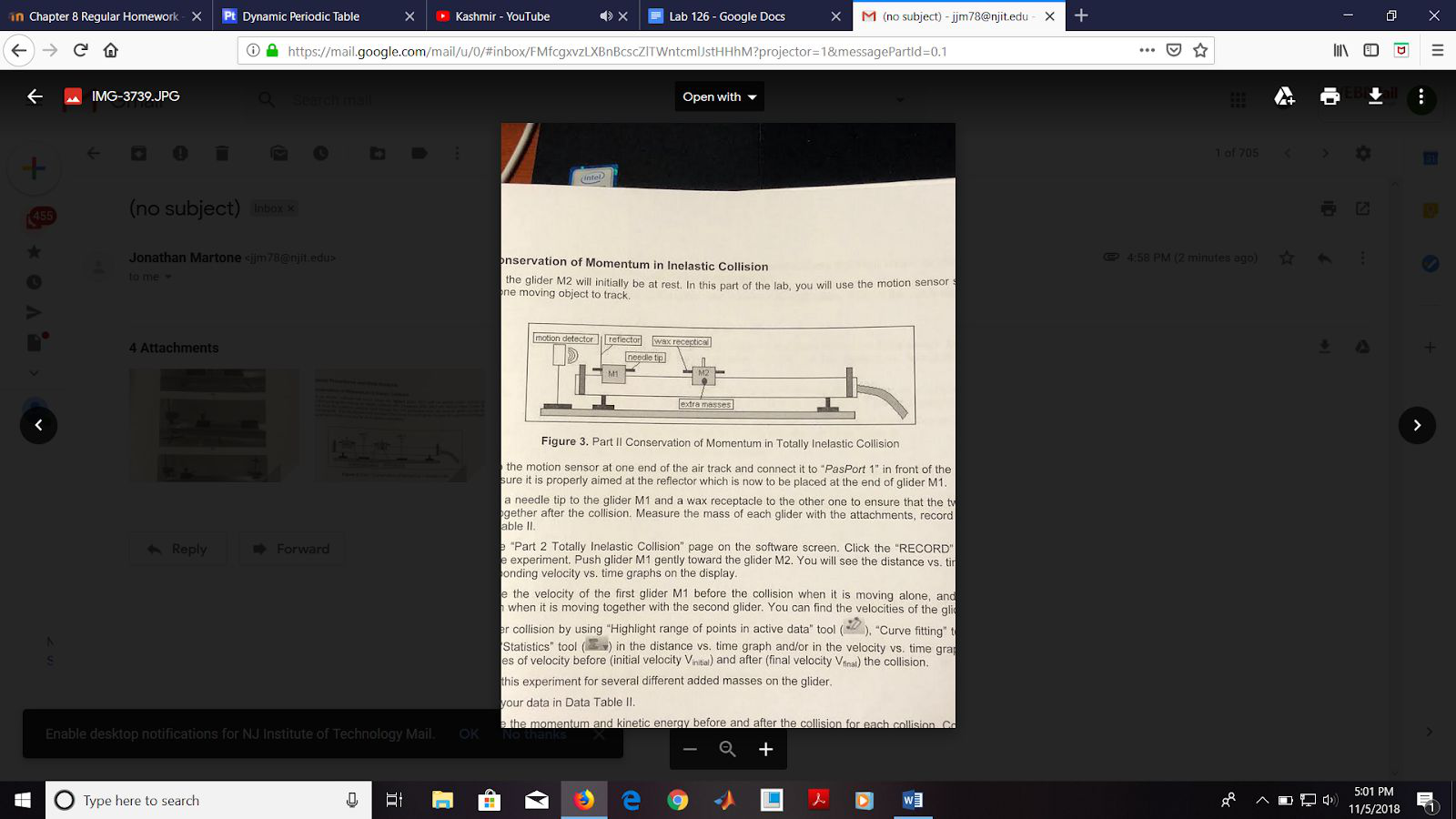Press the power push button the left front corner the interface
1. Log in to the lab computer using your UCID and password.
2. Connect the USB cable of the 850 Universal Interface to a USB port on the computer. Connect the AC adapter power cord to an electrical outlet under the lab table.
2. Place the two gliders with the attachments on the air track. Turn on the power of the air supply and adjust air flow rate to make the air track frictionless condition.
3. Make sure that the air track is leveled (horizontal) before each experiment by observing for any motion of the gliders on the air track.
M2 and make sure that collision (contact) between the two gliders takes place only while they are both between the gates (do a test run to be sure).
9. Click “RECORD” button on the bottom of the screen to start collecting data and then gently push the glider M1 toward the glider M2. Observe the motion of the glider before and after the collision.
Part II. Conservation of Momentum in an Inelastic Collision
In Figure 3 the glider M2 will initially be at rest. In this part of the lab, you will use the motion sensor since we have only one moving object to track.1. Set up the motion sensor at one end of the air track and connect it to “PasPort 1” in front of the interface. Make sure it is properly aimed at the reflector which is now to be placed at the end of glider M1.
You can find the velocities of the glider before and after the collision by using the “Highlight range of points in active data” tool, the “Curve fitting” tool, and/or the “Statistics” tool in the distance vs. time graph and/or in the velocity vs. time graph. Obtain the values of velocity before (initial velocity Vinitial) and after (final velocity Vfinal) the collision.
5. Repeat this experiment for several different added masses on the glider.
2. Connect the motion sensor to “PasPort 1” in front of the interface and the force sensor to
PasPort 2”. Press the “Zero” button on the force sensor while no force is applied. 3. Attach the reflector and bumper to the glider and measure its total mass. Record the value (M) in Data Table III.4. Place the glider close to the motion sensor on the air track.
8. For each trial with different glider masses, calculate the momentum and its change for the glider before and after colliding with the force sensor.
9. Compare the impulse J with the change in momentum (find % difference), and verify the Impulse-Momentum Theorem.
| Trial # |
|
|
|
||||
|---|---|---|---|---|---|---|---|
| 1 | 0.273 | 0 | 0.273 | -0.064 | 0.278 | 0.214 | 21.61% |
KE1: kinetic energy of Glider M1 before collision
KE1’: linear momentum of Glider M1 after collision
KE2: kinetic energy of Glider M1 before collision
KE2’: linear momentum of Glider M1 after collision
|
|
||||||
|---|---|---|---|---|---|---|---|
| 1 | 0.186 | 0 | 0.186 | 0.010 | 0.129 | 0.139 | 25.27% |
| 2 | 0.127 | 0 | 0.127 | 0.014 | 0.122 | 0.136 | 7.09% |
| 3 | 0.105 | 0 | 0.105 | 0 | 0.122 | 0.122 | 16.19% |
|
|
Δt [s] | ||||||
|---|---|---|---|---|---|---|---|---|
|
|
-0.3579 | 0.07751 | |||||
|
|
-0.1918 |
|
0.04569 | ||||
|
-0.1136 |
|
|
0.02269 |
4) KE After Collision = ½M1V1’2 + ½M2V2’2 → (.5)(.2)(0.4902) + (.5)(.1895)(0.4902 ) → 0.047
c) Table 3
i) Trial 1
1) ΔP = m (V’ - V) → .3(-0.555 - 0.638) → -0.3579
2) % Difference = |(J - ΔP) / (J + ΔP)| * 100 → |(0.33698 - 0.3579)/(0.33698 + 0.3579)| * 100 = 3.01%
ii) Trial 2
1) ΔP = m (V’ - V) → .25(-0.265 - 0.502) → -0.1918
2) % Difference = |(J - ΔP) / (J + ΔP)| * 100 → |(0.20768 - 0.1918) / (0.20768 + 0.1918)| * 100 = 3.98%
iii) Trial 3
1) ΔP = m (V’ - V) → .2(-0.263 - 0.305) → -0.1136
2) % Difference = |(J - ΔP) / (J + ΔP)| * 100 → |(0.11943 - 0.1136) / (0.11943 + 0.1136)| * 100 = 2.50%IV. Analysis and Discussion
The purpose of this lab was to understand the conservation of momentum for fully elastic and totally inelastic. Additionally, the group was able to verify the
Impulse-Momentum Theorem. This experiment demonstrated power and impulse principles using velocity, kinetic energy, and time.successfully understood the conversation of momentum and verified the impulse-momentum theorem. Our results met the objective of the experiment.
1. In Part I, calculate the % difference of linear momentum and kinetic energy before and after the collision. What would cause the difference?
V. Conclusions
In this lab, our group used an air track, gliders, and a variety of trial-specific attachments in order to verify the conservation of momentum for fully elastic and totally inelastic collisions.Additionally, this allowed us to verify the Impulse-Momentum theorem. Again, this theorem states that the change in momentum of an object is equal to the impulse applied to it. While generally this lab was carried out with few problems, the final percent error values derived

